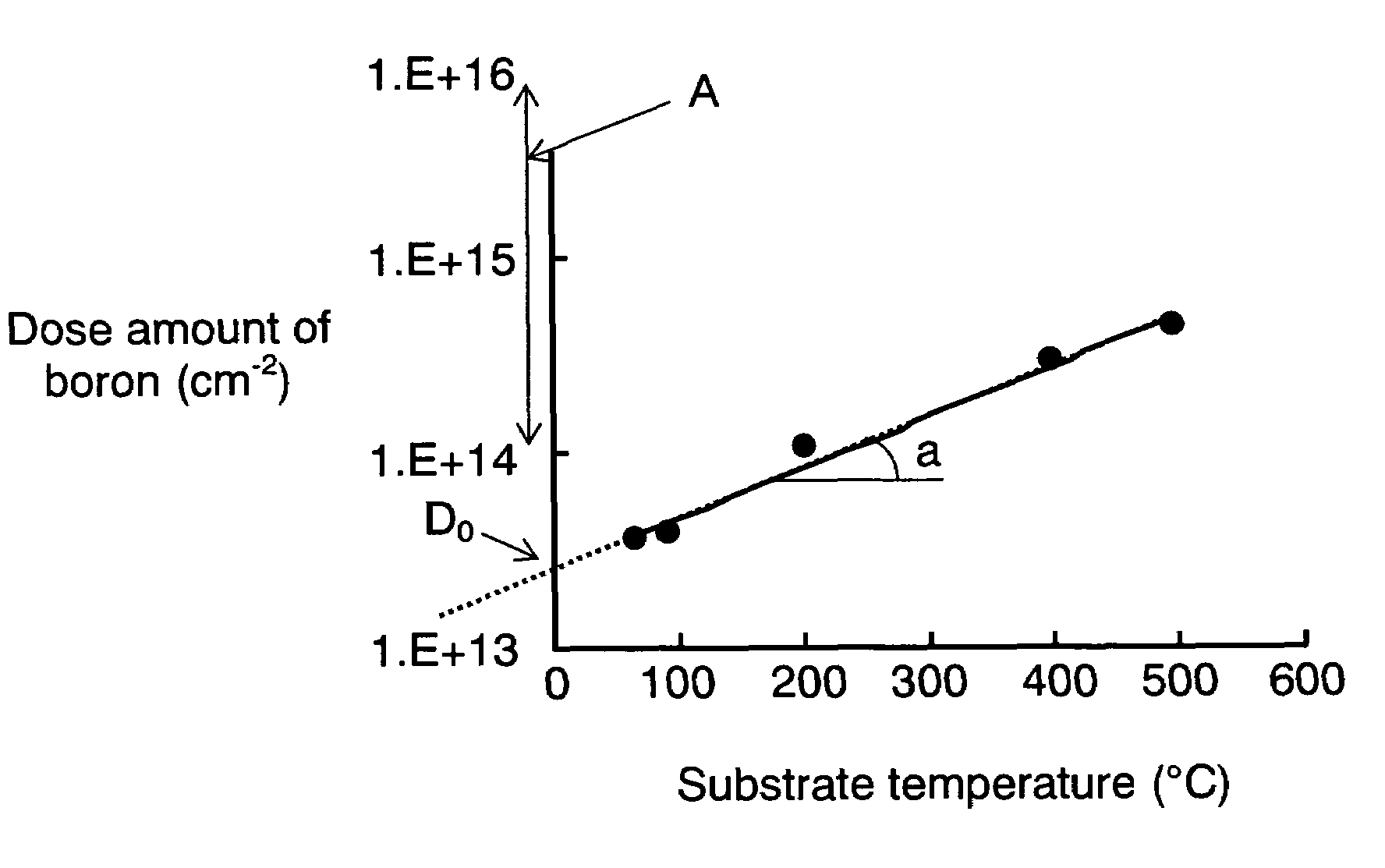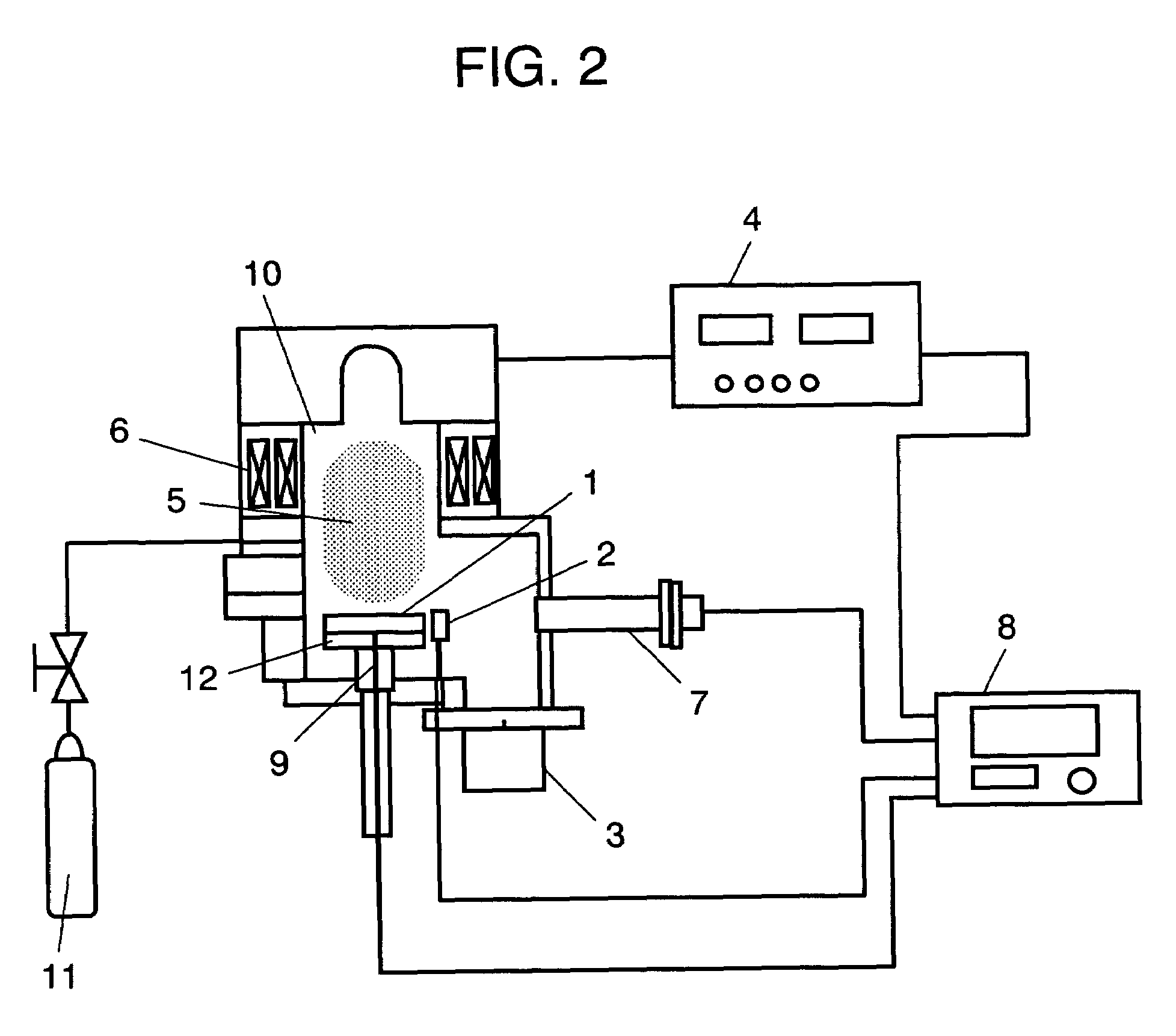Method of controlling impurity doping and impurity doping apparatus
a technology of impurity doping and impurity doping apparatus, which is applied in the direction of measurement devices, semiconductor/solid-state device testing/measurement, instruments, etc., can solve the problems of insufficient consistency in correlation and the inability to reduce the variance of semiconductor characteristics, so as to minimize the variation in quality and improve the accuracy. , the effect of high accuracy
- Summary
- Abstract
- Description
- Claims
- Application Information
AI Technical Summary
Benefits of technology
Problems solved by technology
Method used
Image
Examples
first exemplary embodiment
[0049]The description given in connection with this embodiment is about results of gas-doping in which boron was doped into a silicon substrate. In the experiment, a silicon substrate disposed in a chamber underwent helium (He)-plasma irradiation for 20 seconds. Following the completion of the He-plasma irradiation, diborrane (B2H6) gas, which was diluted with helium (He) to have concentration of 5%, was fed into the chamber for 7 seconds with pressure of 1 Pa. While the B2H6 gas was being fed, the surface temperature of the substrate was increased from 60° C. to 500° C. According to the gas-doping through the process above, the relationship between the dose amount of boron and the substrate temperature is similar to that shown in FIG. 1. The relationship between the dose amount of boron (Dgas) and the substrate temperature (T) is expressed by equation (1):
Dgas=D0·exp(a·T) (1),
[0050]where, Dgas represents the dose amount (cm-2) of boron; D0 represents the dose amount (cm−2) of boro...
second exemplary embodiment
[0057]The description given in connection with this embodiment is about results of plasma-doping in which a dose amount of boron of 3.5×1014 cm−2 was doped into a silicon substrate. In the experiment, a silicon substrate disposed in a chamber underwent diborrane (B2H6)-plasma irradiation for 7 seconds. In the plasma irradiation, the B2H6-gas, which was diluted with helium (He) to have concentration of 0.025%, was fed into the chamber with pressure of 0.9 Pa. While the B2H6-gas was being fed, a bias voltage of 100V—biased by 600 kHz-high frequency power supply—was applied to the silicon substrate. The source power was set at 1500 W. The surface temperature of the substrate was kept at 0° C.
[0058]In this case, an amount of B2H6-gas, which is estimated by gas analyzer 7 under a substrate temperature of 0° C., measures 3×1013 cm−2. According to Faraday cup as ion analyzer 2, the estimated dose amount measures 3.2×1014 cm−2. On the other hand, the SIMS (Secondary Ion Mass Spectrometry) m...
third exemplary embodiment
[0061]In the third embodiment, like the previous embodiment, boron is doped into a silicon substrate by plasma-doping. The target dose amount is 3.5×1014 cm−2. In the experiment, a silicon substrate disposed in a chamber underwent diborrane (B2H6)-plasma irradiation for 60 seconds. In the plasma irradiation, the B2H6-gas, which was diluted with helium (He) to have concentration of 0.025%, was fed into the chamber with pressure of 0.9 Pa. While the B2H6-gas was being fed, a bias voltage of 100V—biased by 600 kHz-high frequency power supply—was applied to the silicon substrate. The source power was set at 1500 W. The surface temperature of the substrate was kept at 0° C. The doping conditions of the embodiment are the same as those of the second embodiment, except for the plasma-irradiating time.
[0062]In this case, an amount of B2H6-gas, which is estimated by gas analyzer 7 under a substrate temperature of 0° C., measures 3×1013 cm−2. The dose amount by gas is, as described above, not...
PUM
 Login to View More
Login to View More Abstract
Description
Claims
Application Information
 Login to View More
Login to View More - R&D
- Intellectual Property
- Life Sciences
- Materials
- Tech Scout
- Unparalleled Data Quality
- Higher Quality Content
- 60% Fewer Hallucinations
Browse by: Latest US Patents, China's latest patents, Technical Efficacy Thesaurus, Application Domain, Technology Topic, Popular Technical Reports.
© 2025 PatSnap. All rights reserved.Legal|Privacy policy|Modern Slavery Act Transparency Statement|Sitemap|About US| Contact US: help@patsnap.com



